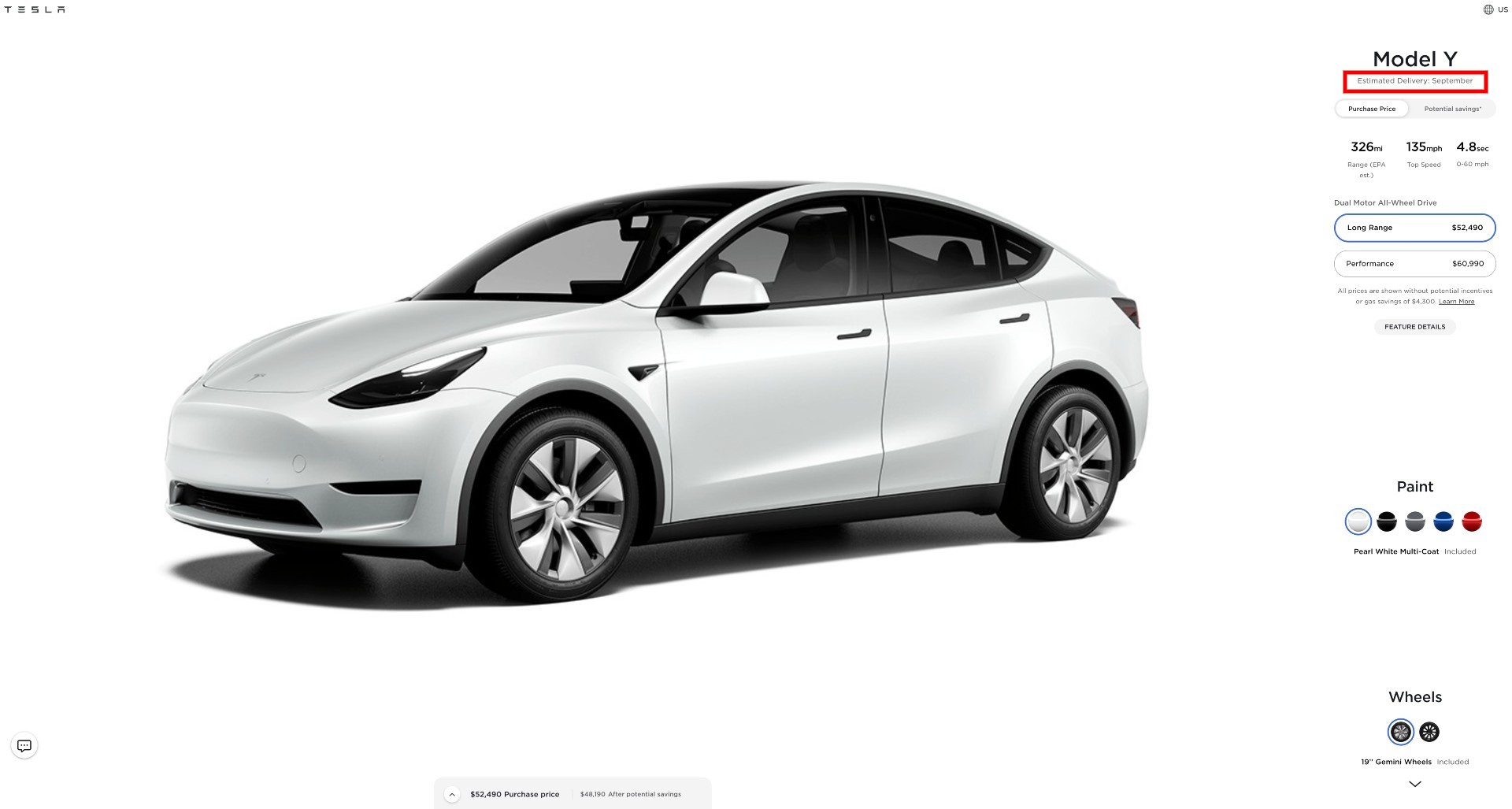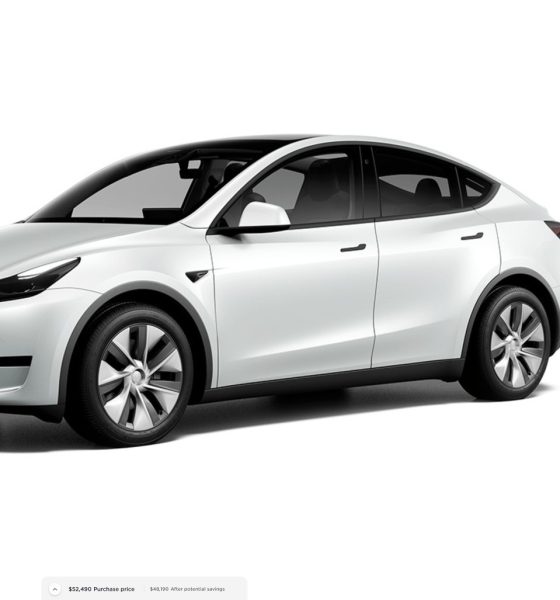The demand for the Tesla Model Y Long Range variant is skyrocketing as the company now outlines the soonest possible date to take delivery in September, meaning the vehicle is nearly sold out in Q3, even though it is still Q2.
After releasing the all-electric crossover last year, Tesla CEO Elon Musk predicted that the Model Y would overtake the Model 3 in terms of popularity. In several markets, like China and more locally in California, the Model Y has already established itself as the overachieving little brother because people are tending to buy the all-electric crossover more than the all-electric sedan.
As Tesla continues to ramp up its manufacturing efforts for all of its vehicles, the Model Y is the main focus of the automaker as it expands into new regions. In Austin at Giga Texas, the Model Y and the Cybertruck will take center stage when the facility begins manufacturing the vehicles by the end of 2021. This plan is reflected with the Model Y in Europe, where Tesla’s first Gigafactory on the continent in Germany will manufacture the Model Y straight out of the gate later this year.
However, demand is becoming a bit overwhelming for Tesla as it aims to complete two new factories by the end of 2021. The company’s cars are becoming so popular in so many regions that delivery dates are becoming more prolonged, meaning the need for additional production facilities is becoming more apparent as the transition to sustainable energy continues to leap forward.
It was hinted in early May that Tesla had already sold out of Q2 production volume because of increasing demand. While that is still an amazing accomplishment, Tesla is already starting to sell out for the next quarter with at least one of its cars. The Model Y Long Range is proving to be Tesla’s biggest seller, it appears, as the company is estimating the earliest delivery date will be September, the final month of 2021’s Q3.

Credit: Tesla
The demand has led to Tesla increasing the prices of the Model Y by $3,500 so far this year, after cutting the cost of the car significantly in February. Tesla has avoided encountering severe problems due to the global chip shortage. Still, demand and some parts shortages have resulted in Tesla hiking the prices of its two mass-market vehicles in 2021.
Tesla has made several changes to the Model Y this year, including removing a lumbar-support option in the passenger’s seat. One of the biggest changes, however, is Tesla’s removal of radar equipment in the Y and the 3, a move that Tesla has long considered in its quest for Full Self-Driving.
Nevertheless, the demand for the Model Y is skyrocketing based on recent registration figures. The Model Y overtook the Model 3 in April, according to the EV Sales Blog’s Global sales figures. It sold 16,232 units compared to the Model 3’s 14,980. The Model 3 retained the title of most popular EV in 2021, but the Model Y sits in third, just behind the Wuling HongGuang Mini EV from the GM-SAIC-Wuling venture in China.
CEO Elon Musk predicted earlier this year that the Model Y would be the best-selling vehicle globally in 2022. “When it comes to Model Y, we think Model Y will be the best-selling car or vehicle of any kind in the world and probably next year,” he said during the Q1 2021 Earnings Call. “So I’m not 100% certain next year, but I think it’s quite likely. I’d say more likely than not that in 2022, Model Y is the best-selling car or truck of any kind in the world.”
The Model Y was the first vehicle in Tesla history to be profitable in its first quarter of production. The demand for the Model Y and its evident growth through sales figures from various outlets bodes well for Tesla’s financials. The company will aim for its eighth-consecutive profitable quarter when it reports its earnings sometime next month.

News
Elon Musk’s Grokipedia surges to 5.6M articles, almost 79% of English Wikipedia
The explosive growth marks a major milestone for the AI-powered online encyclopedia, which was launched by Elon Musk’s xAI just months ago.

Elon Musk’s Grokipedia has grown to an impressive 5,615,201 articles as of today, closing in on 79% of the English Wikipedia’s current total of 7,119,376 articles.
The explosive growth marks a major milestone for the AI-powered online encyclopedia, which was launched by Elon Musk’s xAI just months ago. Needless to say, it would only be a matter of time before Grokipedia exceeds English Wikipedia in sheer volume.
Grokipedia’s rapid growth
xAI’s vision for Grokipedia emphasizes neutrality, while Grok’s reasoning capabilities allow for fast drafting and fact-checking. When Elon Musk announced the initiative in late September 2025, he noted that Grokipedia would be an improvement to Wikipedia because it would be designed to avoid bias.
At the time, Musk noted that Grokipedia “is a necessary step towards the xAI goal of understanding the Universe.”
Grokipedia was launched in late October, and while xAI was careful to list it only as Version 0.1 at the time, the online encyclopedia immediately earned praise. Wikipedia co-founder Larry Sanger highlighted the project’s innovative approach, noting how it leverages AI to fill knowledge gaps and enable rapid updates. Netizens also observed how Grokipedia tends to present articles in a more objective manner compared to Wikipedia, which is edited by humans.
Elon Musk’s ambitious plans
With 5,615,201 total articles, Grokipedia has now grown to almost 79% of English Wikipedia’s article base. This is incredibly quick, though Grokipedia remains text-only for now. xAI, for its part, has now updated the online encyclopedia’s iteration to v0.2.
Elon Musk has shared bold ideas for Grokipedia, including sending a record of the entire knowledge base to space as part of xAI’s mission to preserve and expand human understanding. At some point, Musk stated that Grokipedia will be renamed to Encyclopedia Galactica, and it will be sent to the cosmos.
“When Grokipedia is good enough (long way to go), we will change the name to Encyclopedia Galactica. It will be an open source distillation of all knowledge, including audio, images and video. Join xAI to help build the sci-fi version of the Library of Alexandria!” Musk wrote, adding in a later post that “Copies will be etched in stone and sent to the Moon, Mars and beyond. This time, it will not be lost.”
News
Tesla Model 3 becomes Netherlands’ best-selling used EV in 2025
More than one in ten second-hand electric cars sold in the country last year was a Tesla Model 3.

The Tesla Model 3 became the most popular used electric car in the Netherlands in 2025, cementing its dominance well beyond the country’s new-car market.
After years at the top of Dutch EV sales charts, the Model 3 now leads the country’s second-hand EV market by a wide margin, as record used-car purchases pushed electric vehicles further into the mainstream.
Model 3 takes a commanding lead
The Netherlands recorded more than 2.1 million used car sales last year, the highest level on record. Of those, roughly 4.8%, or about 102,000 vehicles, were electric. Within that growing segment, the Tesla Model 3 stood far ahead of its competitors.
In 2025 alone, 11,338 used Model 3s changed hands, giving the car an 11.1% share of the country’s entire used EV market. That means more than one in ten second-hand electric cars sold in the country last year was a Tesla Model 3, Auto Week Netherlands reported. The scale of its lead is striking: the gap between the Model 3 and the second-place finisher, the Volkswagen ID3, is more than 6,700 vehicles.
Rivals trail as residual values shape rankings
The Volkswagen ID.3 ranked a distant second, with 4,595 used units sold and a 4.5% market share. Close behind was the Audi e-tron, which placed third with 4,236 registrations. As noted by Auto Week Netherlands, relatively low residual values likely boosted the e-tron’s appeal in the used market, despite its higher original price.
Other strong performers included the Kia Niro, the Tesla Model Y, and the Hyundai Kona, highlighting continued demand for compact and midsize electric vehicles with proven range and reliability. No other model, however, came close to matching the Model 3’s scale or market presence.
News
Tesla Model Y Standard Long Range RWD launches in Europe
The update was announced by Tesla Europe & Middle East in a post on its official social media account on X.

Tesla has expanded the Model Y lineup in Europe with the introduction of the Standard Long Range RWD variant, which offers an impressive 657 km of WLTP range.
The update was announced by Tesla Europe & Middle East in a post on its official social media account on X.
Model Y Standard Long Range RWD Details
Tesla Europe & Middle East highlighted some of the Model Y Standard Long Range RWD’s most notable specs, from its 657 km of WLTP range to its 2,118 liters of cargo volume. More importantly, Tesla also noted that the newly released variant only consumes 12.7 kWh per 100 km, making it the most efficient Model Y to date.
The Model Y Standard provides a lower entry point for consumers who wish to enter the Tesla ecosystem at the lowest possible price. While the Model 3 Standard is still more affordable, some consumers might prefer the Model Y Standard due to its larger size and crossover form factor. The fact that the Model Y Standard is equipped with Tesla’s AI4 computer also makes it ready for FSD’s eventual rollout to the region.
Top Gear’s Model Y Standard review
Top Gear‘s recent review of the Tesla Model Y Standard highlighted some of the vehicle’s most notable features, such as its impressive real-world range, stellar infotainment system, and spacious interior. As per the publication, the Model Y Standard still retains a lot of what makes Tesla’s vehicles well-rounded, even if it’s been equipped with a simplified interior.
Top Gear compared the Model Y Standard to its rivals in the same segment. “The introduction of the Standard trim brings the Model Y in line with the entry price of most of its closest competition. In fact, it’s actually cheaper than a Peugeot e-3008 and costs £5k less than an entry-level Audi Q4 e-tron. It also makes the Ford Mustang Mach-E look a little short with its higher entry price and worse range,” the publication wrote.










